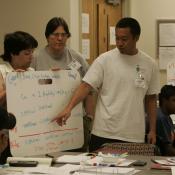Modeling Instruction
Impact
As of 2021, greater than 15,000 teachers have participated in summer workshops or other professional development involving Modeling Instruction. It is estimated that Modeling teachers reach more than 100,000 students each year. Originally developed at Arizona State University, Modeling Instruction is now used by more than 10% of physics teachers nationwide. It received the 2014 Excellence in Physics Education Award by the American Physical Society. Student achievement on tests of concept understanding is typically double that of traditional instruction. Models and theories are the purpose and the outcomes of scientific practices. They are the tools for engineering design and problem solving. Thus, modeling guides all other practices.
Contact
Accomplished
- Need Accomplished
- Evaluation Accomplished
- Sustainability Accomplished
- Replication & Scalability Accomplished
- Partnerships Accomplished
- Capacity Accomplished
- Challenging & Relevant Content Accomplished
- STEM Practices Accomplished
- Inspiration Accomplished
- Under-Represented Groups Accomplished

I teach in a very high needs school in Phoenix. Due to an extreme shortage, they asked me to teach physics. ASU Modeling Workshops have been an incredible resource for me; my administrators are constantly impressed by my teaching methods and I owe it all to modeling.
Design Principles
The programs in this database clear a high bar. STEMworks reviewed each program against the Design Principles for Effective STEM Philanthropy. Programs must be Accomplished () across all Design Principles, or be Developing (
) in a maximum of three areas.
Overarching Principles
-
Need Accomplished
Identify and target a compelling and well-defined need.
-
Evaluation Accomplished
Use rigorous evaluation to continuously measure and inform progress towards the compelling need identified.
-
Sustainability Accomplished
Ensure work is sustainable.
-
Replication & Scalability Accomplished
Demonstrate replicability and scalability.
-
Partnerships Accomplished
Create high impact partnerships.
-
Capacity Accomplished
Ensure organizational capacity to achieve goals.
STEM Principles
-
Challenging & Relevant Content Accomplished
Offer challenging and relevant STEM content for the target audience.
-
STEM Practices Accomplished
Incorporate and encourage STEM practices.
-
Inspiration Accomplished
Inspire interest and engagement in STEM.
-
Under-Represented Groups Accomplished
Identify and address the needs of under-represented groups.
Program Overview
Modeling Instruction is an innovative and successful approach to science teacher development. At a time when many physical science teachers are teaching out of field, this program improves learning and achievement of K-12 students in science and mathematics by providing model-centered professional development for teachers in grades 8 through 12. Instead of relying on lectures and textbooks, Modeling Instruction emphasizes active student construction of conceptual and mathematical models in an interactive learning community. Teachers engage students with simple scenarios where students learn to model the physical world. Modeling instruction emphasizes experimental design. It develops students’ ability to analyze data, reach a conclusion, and defend that conclusion. Other 21st century skills developed include scientific use of computers and probeware, teamwork, and verbal and written communication skills. Students become self-directed, independent learners.
Funders and Partners
In the early 1990s, after a decade of education research to develop and validate Modeling InstructionTM, Dr. David Hestenes was awarded grants from the National Science Foundation for another decade to spread the Modeling InstructionTM program nationwide. As of 2021, greater than 15,000 teachers have participated in summer workshops or other professional development involving Modeling Instruction, including nearly 10% of the United States’ high school physics teachers. It is estimated that Modeling teachers reach more than 100,000 students each year.
AMTA was created by teachers to continue and expand the mission after government funding for Modeling InstructionTM ended. The AMTA has expanded to a nationwide community of teachers dedicated to addressing the nation’s Science, Technology, Engineering, and Mathematics (STEM) education crisis.